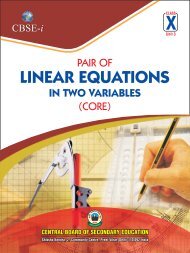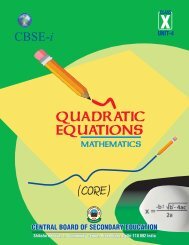CBSEi Class 10 Sequences (AP and GP) CORE
CBSEi Class 10 Sequences (AP and GP) CORE
CBSEi Class 10 Sequences (AP and GP) CORE
Create successful ePaper yourself
Turn your PDF publications into a flip-book with our unique Google optimized e-Paper software.
From (1) <strong>and</strong> (2), 3k 8 = 4 k<br />
or, k = 3.<br />
Thus, for k=3, the given three terms will form an <strong>AP</strong>.<br />
Example 6: Find <strong>AP</strong> whose first term is —2 <strong>and</strong> common difference is —5.<br />
Solution: Here a = 2, d = 5<br />
So, the required <strong>AP</strong> will be<br />
a, a+d, a+2d,……<br />
or 2, 2+( 5), 2 + 2( 5),….<br />
or, 2, 7, 12,…..<br />
General Term of an <strong>AP</strong><br />
Recall that if a is the first term <strong>and</strong> d is the common difference, then the <strong>AP</strong> is<br />
written as<br />
a, a+d, a+2d, ….<br />
Note that<br />
first term( ) = a = a + (1 1) d<br />
second term ( ) = a + d = a + (2 1) d<br />
third term ( ) = a + 2d = a + (3 1) d<br />
fourth term ( ) = a + 3d = a + (4 1) d<br />
…….<br />
tenth term ( ) = a + 9d = a + (<strong>10</strong> – 1) d<br />
50 th term ( ) = a + 49d = a + (50 – 1) d<br />
Observing the pattern (coefficient of d in any term is 1 less than the term number),<br />
we can write nth term ( )= a + (n 1) d<br />
= a + (n 1) d<br />
48

















